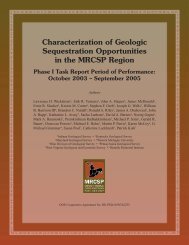Unraveling the stratigraphy of the Oriskany Sandstone: A necessity ...
Unraveling the stratigraphy of the Oriskany Sandstone: A necessity ...
Unraveling the stratigraphy of the Oriskany Sandstone: A necessity ...
Create successful ePaper yourself
Turn your PDF publications into a flip-book with our unique Google optimized e-Paper software.
STRUCTURAL PLAY (DOS)<br />
The <strong>Oriskany</strong> <strong>Sandstone</strong> structural play (Dos) is <strong>the</strong> easternmost<br />
<strong>Oriskany</strong> play in <strong>the</strong> Appalachian Basin and<br />
extends from New York through central Pennsylvania,<br />
south to western Maryland, and eastern West Virginia<br />
(Figure 2). The play is divided into three subplays based<br />
on structural type and whe<strong>the</strong>r or not stratigraphic trapping<br />
mechanisms are also observed (Harper and Patchen,<br />
1996). The three subplays include (1) <strong>the</strong> Valley and<br />
Ridge subplay, (2) <strong>the</strong> Appalachian Plateau subplay,<br />
and (3) <strong>the</strong> combination structure/pinch-out subplay<br />
in New York, which also includes pools adjacent to <strong>the</strong><br />
<strong>Oriskany</strong> no-sand areas in northwestern Pennsylvania.<br />
The Valley and Ridge subplay consists <strong>of</strong> multiple eastdipping<br />
thrust sheets and is situated in south-central<br />
Pennsylvania, west-central Maryland, eastern West Virginia,<br />
and northwestern Virginia. The Appalachian Plateau<br />
subplay occurs at <strong>the</strong> western and nor<strong>the</strong>rn boundaries<br />
<strong>of</strong> <strong>the</strong> play and results from complex structures<br />
originating through detachment in Silurian salt beds and<br />
Ordovician shales. The combination structure/pinchout<br />
subplay is identical with <strong>the</strong> Appalachian Plateau<br />
subplay, with <strong>the</strong> exception <strong>of</strong> stratigraphic trapping<br />
and diagenetic changes observed adjacent to pinch-out<br />
areas (Harper and Patchen, 1996).<br />
<strong>Oriskany</strong> thicknesses in <strong>the</strong> Dos play range from 0<br />
to more than 300 ft (91 m). Adjacent to <strong>the</strong> <strong>Oriskany</strong><br />
no-sand area, <strong>the</strong> reservoir sandstone typically averages<br />
between 10 and 30 ft (3 and 9 m) thick (Finn, 1949;<br />
Abel and Heyman, 1981; Opritza, 1996). Thicker zones<br />
<strong>of</strong> <strong>Oriskany</strong> typically occur in <strong>the</strong> more structurally complex<br />
areas where thrusting and vertical repetition <strong>of</strong> beds<br />
cause apparent thicknesses up to as much as 350 ft<br />
(107 m) in western Maryland (Harper and Patchen,<br />
1996; Patchen and Harper, 1996). The <strong>Oriskany</strong> outcrops<br />
in parts <strong>of</strong> Pennsylvania and Maryland and extends<br />
to depths <strong>of</strong> at least 7500 ft (2286 m) in Bedford County,<br />
Pennsylvania. On structural highs, <strong>the</strong> <strong>Oriskany</strong> may be<br />
present at depths shallower than 2500 ft (762 m), which<br />
would make it unsuitable for geologic sequestration in<br />
<strong>the</strong>se locations (Figure 3).<br />
Petrophysical Evaluation<br />
Geophysical logs from Pennsylvania and New York and<br />
an existing core from <strong>the</strong> Theodore C. Sipe 1 well in<br />
Somerset County, Pennsylvania, were used to evaluate<br />
this play. Nine geophysical logs from Steuben, Schuyler,<br />
Broome, and Chemung counties, New York, and three<br />
198 Sequestration Potential <strong>of</strong> <strong>the</strong> <strong>Oriskany</strong> <strong>Sandstone</strong><br />
wells in Somerset County, Pennsylvania, were used to<br />
calculate porosity values. The Somerset wells are located<br />
within 3 mi (4.8 km) to <strong>the</strong> west-northwest <strong>of</strong><br />
<strong>the</strong> Theodore C. Sipe 1 well. Somerset County porosity<br />
values range from 0.5 to 2.5%, with an average value <strong>of</strong><br />
1.35%. Calculated porosities from <strong>the</strong> New York geophysical<br />
logs range from 1.1 to 7.3%, with an average<br />
porosity <strong>of</strong> 4.2%. Existing core data were obtained from<br />
<strong>the</strong> Brown Hill well, located in Tioga field, Tioga County,<br />
Pennsylvania.<br />
Core and Petrographic Data<br />
The only core in <strong>the</strong> Dos play available for sampling as<br />
part <strong>of</strong> <strong>the</strong> current study is <strong>the</strong> Theodore C. Sipe 1 well in<br />
Somerset County, Pennsylvania. This well, drilled in 1979,<br />
was a dry hole targeting <strong>the</strong> <strong>Oriskany</strong> <strong>Sandstone</strong>. The<br />
cored interval is from 8830 to 8902 ft (2691 to 2713 m).<br />
Welsh (1984) interpreted <strong>the</strong> core as an <strong>of</strong>fshore marine<br />
complex consisting <strong>of</strong> an overall coarsening-upward sequence<br />
<strong>of</strong> <strong>the</strong> sand bar and shelf sediments. Four depositional<br />
facies are represented in <strong>the</strong> core: deeper shelf,<br />
interbar (shelf), bar margin, and central bar. Porosity in<br />
most facies is low with <strong>the</strong> only significant porosity existing<br />
in <strong>the</strong> central bar facies (Welsh, 1984).<br />
Samples collected from <strong>the</strong> Theodore C. Sipe 1<br />
well were used for SEM and thin-section analysis. The<br />
interval from 8840.8 to 8884 ft (2694.4 to 2708 m) includes<br />
central bar and bar margin facies. Our sampling<br />
targeted <strong>the</strong> clean sandstone zones based on <strong>the</strong> environmental<br />
interpretations <strong>of</strong> Welsh (1984). Six <strong>of</strong> <strong>the</strong><br />
samples were made into thin sections, and seven <strong>of</strong> <strong>the</strong><br />
samples were analyzed using SEM.<br />
The <strong>Oriskany</strong> in <strong>the</strong> Theodore C. Sipe 1 well is a<br />
very fine to coarse-grained quartz arenite interbedded<br />
with calcareous sandstones. The coarsest sandstones<br />
occur in <strong>the</strong> central bar facies, and <strong>the</strong>y are commonly<br />
planar to trough cross-bedded. Quartz is <strong>the</strong> dominant<br />
clastic component in <strong>the</strong> rock, but we also observed accessory<br />
amounts <strong>of</strong> rutile, apatite, zircon, and pyrite using<br />
SEM and EDS analysis. The calcareous sandstone interbeds<br />
represent <strong>the</strong> interbar (shelf ) environments. Carbonate<br />
is present as both fossil allochems and cement.<br />
The skeletal assemblage includes echinoderms, brachiopods,<br />
bryozoans, and some phosphatic skeletal material.<br />
Skeletal grains average 0.020 to 0.039 in. (0.5 to 1 mm)<br />
in size. The carbonate component <strong>of</strong> <strong>the</strong>se rocks range<br />
from 1 to 30% <strong>of</strong> <strong>the</strong> entire rock based on visual estimations.<br />
Argillaceous laminations are common in both <strong>the</strong><br />
quartz-rich and carbonate zones.





